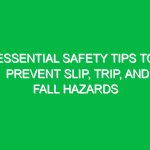Introduction
Hello team! Today, we’re here for a crucial Toolbox Talk focused on Drowsy Driving. As we gear up for our workday, it’s essential that we discuss the risks associated with driving while drowsy and how it can impact our Safety and well-being. Drowsy driving is not just a personal issue; it can have serious implications in our workplace, especially if your job involves operating vehicles or machinery. So let’s dive into this important topic together.
What is Drowsy Driving?
Drowsy driving refers to operating a vehicle while feeling fatigued or sleepy. This condition impairs your ability to make quick decisions, react promptly, and maintain focus on the road. Just like alcohol impairs your driving ability, being drowsy can significantly increase the risk of accidents. Unfortunately, many drivers underestimate how drowsiness affects their performance.
Why is Drowsy Driving a Concern in the Workplace?
In the context of Health, Safety, and Environment (HSE), drowsy driving can lead to accidents that not only endanger the driver but also coworkers and the public. Here are some critical reasons why this topic should matter to all of us:
- Increased Accident Risk: Fatigue can lead to slower reaction times, increased likelihood of making errors, and even falling asleep at the wheel.
- Legal Consequences: Employers can face legal actions if an employee’s drowsy driving leads to an accident, resulting in injuries or fatalities.
- Impact on Productivity: Accidents lead to downtime, which can affect project timelines and productivity.
- Moral Responsibility: We have a duty to look out for each other’s Safety. Ensuring we’re well-rested is part of that responsibility.
Understanding the Risks: Signs of Drowsiness
Recognizing the signs of drowsiness is crucial for preventing drowsy driving. Here are some common symptoms to be aware of:
- Frequent yawning
- Heavy eyelids or difficulty keeping your eyes open
- Difficulty concentrating on the road or surrounding environment
- Memory lapses or difficulties recalling the last few miles driven
- Drifting out of your lane or missing traffic signals
If you notice these signs in yourself or others, it’s crucial to take immediate action.
Real-Life Examples: The Consequences of Drowsy Driving
Let’s consider a hypothetical scenario. Imagine James, a delivery driver, who worked a double shift without adequate rest. On his way back, he started feeling increasingly tired. Ignoring the signs, he continued driving, and eventually, he dozed off for just a few seconds. This resulted in crashing into a parked vehicle, causing damage and injuries. The aftermath included not only physical harm but also legal repercussions and loss of productivity for his company.
Such incidents highlight the importance of being vigilant about our own fatigue levels. Now let’s talk about how we can prevent this from happening.
Best Practices to Combat Drowsy Driving
Preventing drowsy driving is a shared responsibility. Here are several Best Practices to ensure you’re fit for the road:
- Prioritize Sleep: Aim for 7-9 hours of quality sleep each night. Establish a regular sleep schedule and stick to it, even on weekends.
- Take Breaks: If you’re on the road, take regular breaks every 2 hours or every 100 miles to stretch and recharge.
- Use the Buddy System: If you’re feeling tired, ask a coworker to drive or keep you company to help you stay alert.
- Avoid Medications that Cause Drowsiness: If you’re prescribed medication, consult your doctor about its Effects on your ability to drive.
- Stay Hydrated and Eat Well: Dehydration and heavy meals can increase fatigue. Opt for healthy snacks that provide sustained energy.
Strategies for Employers
As an organization, it’s our responsibility to cultivate a culture that prioritizes alertness and safety. Here are some strategies that can be implemented:
- Provide Education: Conduct regular Training sessions on the dangers of drowsy driving, emphasizing its impact on Workplace Safety.
- Encourage Open Communication: Create an environment where employees feel comfortable reporting fatigue or requesting assistance.
- Implement Flexible Schedules: Allow for flexible work hours to accommodate employees who may need to adjust their sleep patterns.
- Monitor Work Hours: Ensure employees do not exceed recommended work hours to prevent fatigue-related incidents.
Regulations and Standards
Understanding the Regulations related to drowsy driving is essential for compliance and safety. The Occupational Safety and Health Administration (OSHA) emphasizes the importance of reducing workplace Hazards, including the risks associated with drowsy driving. Organizations must adhere to safety standards that promote a culture of health and well-being. Failure to comply can result in legal repercussions and a decline in workplace morale.
Open Discussion: Your Thoughts?
Before we wrap up, I’d like to open the floor for discussion. Have any of you experienced or witnessed drowsy driving? What strategies have you found helpful in staying alert? Sharing experiences can help us learn from each other and reinforce the importance of this topic.
Conclusion
In conclusion, Drowsy Driving is a serious concern that affects not only individual safety but also workplace efficiency and legal compliance. By prioritizing sleep, recognizing the signs of fatigue, and implementing Best Practices, we can significantly reduce the risks associated with drowsy driving. Remember, safety starts with each one of us.
Thank you for your attention and commitment to maintaining a safe working environment. Let’s work together to keep our workplace safe and ensure everyone returns home safely each day.


